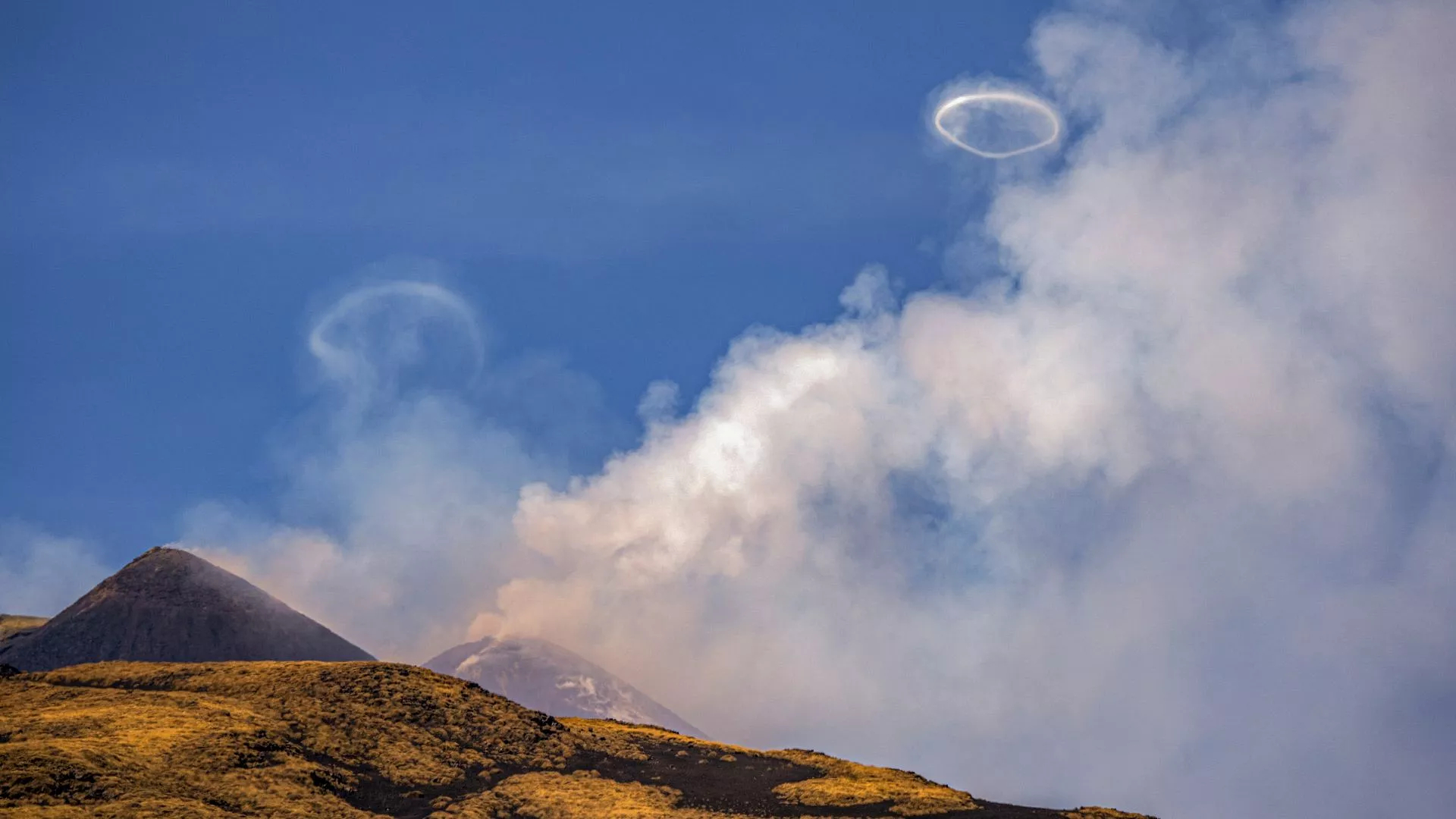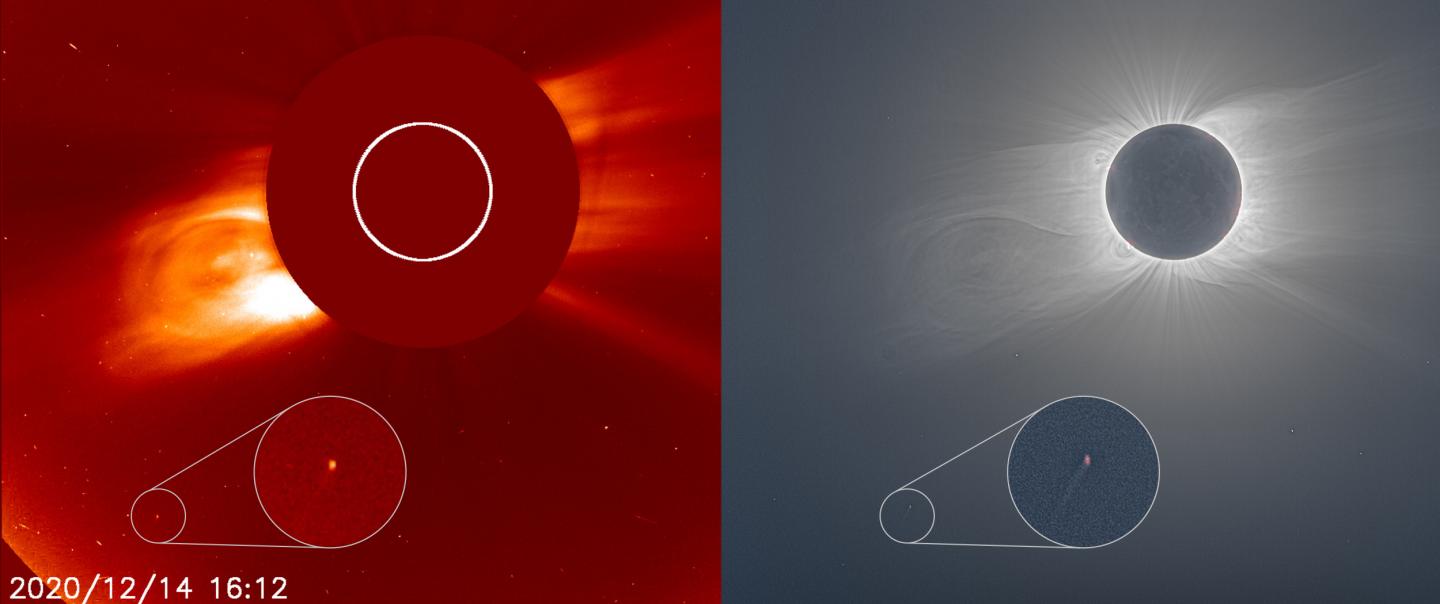Volcanic Vortex Rings

- 12 Apr 2024
Why is it in the News?
Since last week, Mount Etna has been sending up almost perfect rings of smoke into the air which are a rare phenomenon that scientists refer to as volcanic vortex rings.
What are Volcanic Vortex Rings?
- Vortex rings are generated when gas, predominantly water vapor, is released rapidly through a vent in the crater.
- The vent that has opened up in the crater is almost perfectly circular so the rings.
- The phenomenon was first observed at Mt. Etna and Mt. Vesuvius in Italy in 1724 and has been documented in an engraved plate from 1755.
- In more recent times, volcanic vortex rings have been observed at volcanoes such as Redoubt in Alaska, Tungurahua in Ecuador, Pacaya in Guatemala, Eyjafjallajökull and Hekla in Iceland, Stromboli in Italy, Sakurajima in Japan, Yasur in Vanuatu, Whakaari in New Zealand, and Momotombo in Nicaragua.
- According to the report, the rings can remain in the air for up to 10 minutes but tend to disintegrate quickly if conditions are windy and turbulent.
About Mount Etna:
- Mount Etna, sometimes referred to simply as Etna, is an active volcano on the east coast of Sicily, the largest island in the Mediterranean Sea, lying just off the toe of the Italian “boot”.
- Etna’s peak is the highest in Italy south of the Alps, and it is Europe’s largest and one of the most active volcanoes.
- Etna’s summit has five craters, which are responsible for most of the volcano’s eruptions; there are also “flank” eruptions that occur out of 300-odd vents of varying sizes along the slopes of the mountain.
- Etna is in almost constant activity and has seen, since the year 1600, at least 60 flank eruptions and many more summit eruptions.
- In recent years, summit eruptions have occurred in 2006, 2007-08, on two occasions in 2012, 2018, and 2021; flank eruptions have taken place in 2001, 2002-03, 2004-05, and 2008-09.
- Etna has been a World Heritage Site since 2013, and according to UNESCO, the volcano’s eruptive history can be traced back 500,000 years.
- At least 2,700 years of this activity have been documented.
Apple Warns Users of "Mercenary Spyware"

- 12 Apr 2024
Why is it in the News?
Apple has cautioned its users in India and 91 other countries that their iPhone may have come under attack from “mercenary spyware”, including Pegasus, a malware developed by the Israeli company NSO Group.
What are Mercenary Spyware Attacks?
- Mercenary spyware attacks represent an elevated level of cyber threat, characterized by their intricate nature and highly targeted approach.
- These attacks, surpassing typical cybercriminal activity and consumer malware, are meticulously crafted to infiltrate specific individuals with significant resources.
- Due to their sophisticated design and substantial investment, mercenary spyware attacks pose a formidable challenge in terms of detection and prevention.
- Despite their potency, they have primarily targeted select users, leaving the majority relatively unaffected.
- This breed of cyber threat stands as one of the most advanced and elusive globally, prompting tech giant Apple to refrain from attributing them to specific perpetrators or regions.
- The primary objective of mercenary spyware is to clandestinely infiltrate smartphones and other devices, operating without the user's knowledge or consent.
- These surveillance tools are capable of monitoring movements, intercepting communications, and pilfering sensitive data.
- In troubling instances, reports indicate that governments, intelligence agencies, and law enforcement bodies have procured mercenary spyware for surveillance purposes, often targeting political dissidents and activists.
- Key players in the production of mercenary spyware include the NSO Group, FinFisher, and Hacking Team.
- The NSO Group's flagship spyware, Pegasus, facilitates remote infiltration of devices, granting access to calls, emails, messages, and various files.
- Similarly, FinFisher's FinSpy can intercept keystrokes, access data, and activate microphones and cameras without authorization.
- The Hacking Team's Galileo, also known as the Remote Control System (RCS), possesses similar capabilities, including keystroke capture, video call recording, and unauthorized access to device components like the camera and microphone.
About Pegasus Spyware:
- Pegasus Spyware, crafted by Israel's NSO Group, represents a potent cyber threat.
- This sophisticated malware is engineered to exploit zero-click vulnerabilities, granting it access to smartphones without any interaction from the user.
- Once infiltrated, Pegasus gains full control over the targeted device, enabling it to extract a wealth of data, including emails, texts, and phone calls.
- Additionally, it possesses the capability to remotely activate the smartphone's camera and microphone, further compromising the user's privacy.
What are Spyware and Malware?
Spyware:
- Spyware is a type of software that secretly collects information about a user's activities on their computer or device without their knowledge or consent.
- It may track keystrokes, capture browsing habits, record personal information, or monitor online activities.
- Spyware often operates stealthily in the background, making it difficult for users to detect.
Malware:
- Malware, short for malicious software, is a broad term that encompasses various types of harmful software designed to disrupt, damage, or gain unauthorized access to computer systems or networks.
- Malware includes viruses, worms, trojans, ransomware, and other malicious programs.
- Unlike spyware, which focuses on gathering information covertly, malware may aim to corrupt files, steal data, spread across networks, or carry out other harmful actions.
- Malware can enter a system through email attachments, infected websites, removable media, or software downloads from untrusted sources.
World Cybercrime Index

- 12 Apr 2024
Why is it in the News?
A new World Cybercrime Index developed by researchers shows that a majority of cybercriminals come from just a few countries.
About World Cybercrime Index:
- The World Cybercrime Index is a collaborative effort between the University of Oxford and UNSW Canberra that identifies global cybercrime hotspots by ranking countries based on their contribution to cybercrime.
- Data is collected from a survey of 92 cybercrime experts involved in intelligence gathering and investigations.
- The index ranks around 100 countries and identifies key hotspots for various cybercrime categories, such as ransomware, credit card theft, and scams.
Key Findings:
- Russia tops the list, followed by Ukraine, China, the USA, Nigeria, and Romania.
- India ranks 10th in the index, with a balanced distribution of cybercrime types but a notable specialization in scams.
- Certain countries were associated with specific types of cybercrime, like data and identity theft in the United States and technical products or services-related crimes in China.
- These insights highlight the need for international cooperation in addressing cybercrime and its various manifestations across different countries.
According to the Oxford University, the five major categories of cybercrime assessed by the study were:
-
- Technical products/services (e.g. malware coding, botnet access, access to compromised systems, tool production).
- Attacks and extortion (e.g. denial-of-service attacks, ransomware).
- Data/identity theft (e.g. hacking, phishing, account compromises, credit card comprises).
- Scams (e.g. advance fee fraud, business email compromise, online auction fraud).
- Cashing out/money laundering (e.g. credit card fraud, money mules, illicit virtual currency platforms).
Mange Disease

- 12 Apr 2024
Why is it in the News?
The forest department is monitoring an outbreak of mange among a pack of Asiatic wild dogs in the Mudumalai Tiger Reserve (MTR) in the Nilgiris, which they strongly suspect has spread to the animals through the local feral dog population.
What is Mange Disease?
- Mange is a distressing skin condition that affects dogs and is caused by microscopic parasites and different types of mites that infest the dog's skin and coat.
- The two most common forms of mange in dogs are Sarcoptic mange (caused by Sarcoptic scabies mites) and Demodectic mange (caused by Demodex Canis mites).
- Sarcoptic Mange- Scabies: Sarcoptic mange is highly contagious and can spread from dog to dog through direct contact. These microscopic mites burrow into the dog's skin, leading to intense itching and discomfort.
- Demodectic Mange: Demodectic mange, on the other hand, is not usually contagious and often results from an overgrowth of naturally occurring Demodex mites. A weakened immune system or genetic factors can contribute to the development of this form of mange.
- Common Symptoms of Mange in Dogs include:
- Intense Itching
- Skin Infections
- Crusty or Scaly Skin
- Ear Problems
- Mange in dogs is a treatable condition when detected early and managed appropriately.
About Mudumalai Tiger Reserve (MTR):
- The Mudumalai Tiger Reserve, nestled in Tamil Nadu's Nilgiris District at the tri-junction of Karnataka, Kerala, and Tamil Nadu, holds ancient significance, dating back 65 million years to the formation of the Western Ghats.
- It shares borders with the Wayanad Wildlife Sanctuary (Kerala) to the West and the Bandipur Tiger Reserve (Karnataka) to the.
- The Theppakadu Elephant Camp within the reserve is a popular tourist spot, boasting a rich variety of flora and fauna, including Elephants, Gaurs, Tigers, Panthers, and various deer species.
- This historic elephant camp, established over a century ago, sits on the banks of the Moyar River, serving vital roles in human-wildlife conflict resolution, monsoon patrolling, eco-tourism, elephant conservation, and education.
Sungrazing Comet

- 12 Apr 2024
Why is it in the News?
A tiny "sungrazer" comet was discovered, photographed, and destroyed during the recent total solar eclipse — all within 24 hours.
What is a Sungrazing Comet?
- Sungrazing comets are a special class of comets that come very close to the sun at their nearest approach, a point called perihelion.
- To be considered a sungrazer, a comet needs to get within about 850,000 miles from the sun at perihelion.
- Many come even closer, even to within a few thousand miles.
- Being so close to the sun is very hard on comets for many reasons.
- They are subjected to a lot of solar radiation which boils off their water or other volatiles.
- The physical push of the radiation and the solar wind also help form the tails. As they get closer to the sun, the comets experience extremely strong tidal forces or gravitational stress.
- In this hostile environment, many sungrazers do not survive their trip around the sun.
- Although they don't crash into the solar surface, the sun can destroy them anyway.
- Many sungrazing comets follow a similar orbit, called the Kreutz Path, and collectively belong to a population called the Kreutz Group.
- Close to 85% of the sungrazers seen by the SOHO satellite are on this orbital highway.
- Scientists think one extremely large sungrazing comet broke up hundreds, or even thousands, of years ago, and the current comets on the Kreutz Path are the leftover fragments of it.
- Comet Lovejoy, which reached perihelion on December 15, 2011, is the best-known recent Kreutz-group sungrazer.
- And so far, it is the only one that NASA's solar-observing fleet has seen survive its trip around the sun.
What is a Comet?
- A comet is a small celestial body made primarily of ice, dust, and rocky material that orbits the sun in an elongated path.
- When a comet approaches the sun, the heat causes the ice to vaporize, releasing dust and gas into a glowing coma, or halo, around the comet's nucleus.
- This glowing coma often forms a tail that stretches away from the sun due to the solar wind and radiation pressure.
- Comets are often referred to as "dirty snowballs" or "icy dirtballs" because of their composition.
- They are believed to be remnants from the early formation of the solar system and carry important information about its history.
- Comets can have highly elliptical orbits, sometimes taking thousands or even millions of years to complete a single orbit around the sun.
